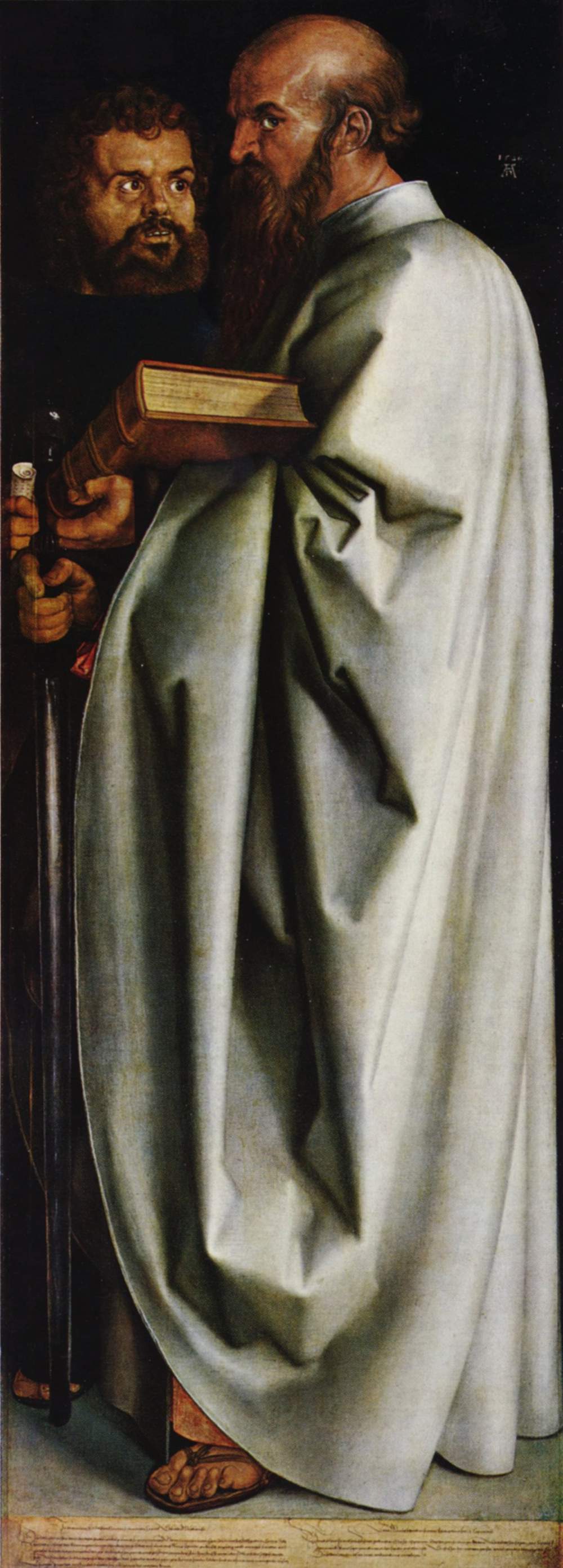Historians debate whether it is accurate to call Dürer a Protestant (at least in part because when he painted this picture the term hadn't been coined yet). But there is no doubt that he greatly admired Martin Luther, who, he wrote, "helped me overcome so many difficulties." Along these lines, the details of Dürer's life-size portrayal of (from left to right) John, Peter, Mark, and Paul (not to mention George and Ringo—wait, that's a different foursome) assert a central plank of the Protestant Reformation: the unique authority and sufficiency of the Bible, the Word of God.
An extreme close-up of the book that John is reading reveals it to be a passage from his Gospel. Similarly, the scroll in Mark's hand bears the opening words of his Gospel in Greek. And Paul appears to bear a Bible in his left hand that corresponds to the blade that represents "the sword of the Spirit, which is the Word of God" in his right.
In the left rear, Peter, who carries the key to the kingdom of heaven, represents Rome and the papacy. The pope claimed (and still claims) to bear the authority of Peter, who is alleged to have been the first bishop of Rome and to be the initial leader of the church based on a number of Scriptural evidences (Matt. 16:16-19; John 21:15-19; Acts 2:1-41; 10:1-11:18). Not denying the biblical importance of the apostle Peter, Dürer includes him with the luminaries in the painting. But notice that he is the only character in the painting not carrying Scripture. Notice also his advanced age and bowed head as he recedes in the background while Luther's favorite New Testament authors, John and Paul, take their place in the front rank. It is hard to view the positions of the apostles without remembering that the sale of indulgences that Luther protested, sparking the Reformation, went to pay for the construction of the new Basilica of St. Peter in Rome.
Dürer painted these two panels for the city council of Nuremberg to urge them to use the power of the state to ensure the preaching of sound, biblical doctrine in the churches. At the bottom of the painting is the following inscription:
All worldly rulers in these dangerous times should give good heed that they receive not human misguidance for the Word of God, for God will have nothing added to His Word nor taken away from it. Here therefore these four excellent men, Peter, John, Paul, and Mark and their warning.Below this Dürer's calligrapher includes quotes from the four biblical writers from Luther's German translation of the New Testament. All the quotes warn against the appearance of false prophets.
Though I'm not a fan of the state using its power to tell churches what to preach, I love this painting and have a reprint hanging in my office. It's a reminder that the Word of God is powerful and that false teaching is more poisonous than a mere empty opinion. It reminds me that the truth of Scripture must be the basis of everything I do as a pastor, as a man, as a Christian. And it reminds me that no matter what one's personality is (see last post), that truth applies to, and must be propounded by, everybody.


i am so glad that there is a blog on this. I asked my teacher the other night that do you think that the tones in the painting are also adding validity to his belief because the catholic side is red and the protestant side is blue. Those are the colors of their flags right catholic with the red cross and protestants with the blue?. She looked at me like an idiot and said no one has ever asked me that question before.......really . I don't know she said. so I hope that you feel the same way i do and is that a correct observation?
ReplyDeleteHello, Anonymous. I'm sorry for the late reply. Thank you for commenting.
ReplyDeleteI have no knowledge of a red Catholic flag and blue Protestant flag. The Catholic flag, to my knowledge, is the flag of the Vatican, which happens to be yellow. (Incidentally, the white flag with the red cross is the flag of England—i.e., not the Union Jack of Great Britain as a whole.) I don't know of a specifically Protestant flag. There is a "Christian flag"; I don't know how old it is, but it looks suspiciously similar in design to the American flag.
When interpreting this painting, it is important to note that "Protestant" and "Catholic" were not yet firm and contrasting categories when Dürer painted it. Dürer had strong sympathies with the Protestant movement within the Catholic Church, so to speak. His depiction of Peter (associated with Rome) present but receding while Mark, John, and Paul hold portions of the Bible with John and Paul (Luther's favorites) in the foreground is what expresses his faith convictions best.
You can learn more about Albrecht Dürer and his works at this great page on Artsy: https://www.artsy.net/artist/albrecht-durer.
ReplyDelete